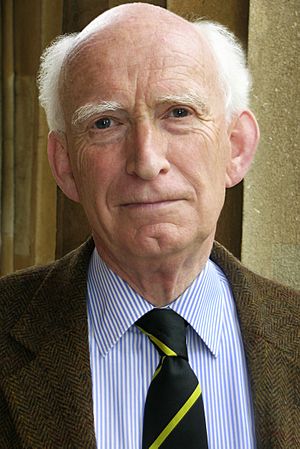Donald Lynden-Bell facts for kids
Quick facts for kids
Donald Lynden-Bell
|
|
|---|---|

Lynden-Bell in 2008
|
|
| Born | 5 April 1935 Dover, United Kingdom
|
| Died | 6 February 2018 (aged 82) Cambridge, United Kingdom
|
| Alma mater | University of Cambridge |
| Awards | Karl Schwarzschild Medal (1983) Eddington Medal (1984) |
| Scientific career | |
| Fields | Astrophysics |
| Institutions | University of Cambridge |
| Thesis | Stellar and galactic dynamics (1961) |
| Doctoral advisor | Leon Mestel |
| Doctoral students | Ofer Lahav Somak Raychaudhury Simon White |
Donald Lynden-Bell (born April 5, 1935 – died February 6, 2018) was a British scientist who studied space, called a theoretical astrophysicist. He made a huge discovery: he was the first to figure out that most galaxies have giant supermassive black holes right in their middle. He also showed that these black holes are what make very bright objects called quasars shine so powerfully.
Lynden-Bell won many awards for his amazing work, including the very first Kavli Prize for Astrophysics. He spent his whole career working at the University of Cambridge in England. There, he became the first director of its Institute of Astronomy.
Contents
Early Life and Education
Donald Lynden-Bell was born on April 5, 1935, in Dover, England. His family was a military family. His father, Lachlan Arthur Lynden-Bell, was a soldier who fought in World War I. Donald had one sister, Jean Monica, who later became a music teacher.
He went to a school called Marlborough College. In 1953, he started studying at Clare College, Cambridge, which is part of the University of Cambridge. He studied advanced mathematics there. After finishing his first degree, he continued his studies to earn a doctorate (Ph.D.). He focused on theoretical astronomy and finished his Ph.D. in 1960.
Discoveries and Research
Donald Lynden-Bell made many important discoveries about how galaxies and stars work.
How Galaxies Form
In 1962, Lynden-Bell worked with other scientists, Olin Eggen and Allan Sandage. They suggested that our own galaxy, the Milky Way, formed from a single, giant cloud of gas that collapsed. This idea helped us understand how galaxies came to be.
Black Holes and Quasars
One of his most famous ideas came out in 1969. He proposed that quasars, which are incredibly bright objects far away in space, get their power from huge supermassive black holes. These black holes pull in gas and dust, and this process creates a lot of energy and light.
He also realized that if quasars are powered by black holes, then most large galaxies today should have a "dead" black hole at their center. This means the black hole is still there, but it's not actively feeding on gas and dust anymore. This idea is now widely accepted by scientists.
Violent Relaxation
Lynden-Bell also developed a theory called "violent relaxation." This idea explains how groups of stars or particles in space settle into their orbits. It shows how their movements change when the gravity around them changes. This theory helps astronomers understand how stars move inside star clusters and galaxies.
Star Clusters and Gravitational Collapse
He also helped develop the idea of the "gravothermal catastrophe." This happens in groups of stars called star clusters. Imagine the center of a star cluster getting smaller and hotter. It then gives off energy to stars further out. This can cause the very center of the cluster to collapse even more.
Young Stars and Disks
In 1974, Lynden-Bell wrote an important paper with James E. Pringle. They studied young stars, which were then called "nebular variables" but are now known as T Tauri stars. These are stars in an early stage of their life. They predicted that these young stars would have disks of gas and dust around them. They also said that these disks would give off a lot of infrared light. Today, finding this extra infrared light is a main way scientists find these young stars.
The Great Attractor
In the 1980s, Lynden-Bell was part of a group of astronomers called the 'Seven Samurai'. They included Sandra Faber and Simon White. This group suggested there was a huge, spread-out region of matter about 250 million light-years away. They called it the Great Attractor. This massive region pulls on our local galaxies, causing them to move in a certain direction.
Career at Cambridge
In 1971, Donald Lynden-Bell became a Professor of Astrophysics at the University of Cambridge. The next year, in 1972, he became the first director of the Institute of Astronomy, Cambridge. This institute was formed when two other astronomy groups at Cambridge joined together.
Personal Life
Donald Lynden-Bell was married to Ruth Lynden-Bell, who was a chemistry professor at the University of Cambridge. They got married on July 1, 1961.
He passed away at his home in Cambridge on February 6, 2018, at the age of 82. He had a stroke a few months before his death and did not fully recover. John Zarnecki, who was the President of the Royal Astronomical Society at the time, praised Lynden-Bell. He said that Donald always asked sharp questions at science meetings and was very supportive of other scientists.
Honours and Awards
Donald Lynden-Bell received many awards for his important work in astrophysics:
- Karl Schwarzschild Medal (1983)
- Eddington Medal (1984)
- Brouwer Award (1991)
- Gold Medal of the Royal Astronomical Society (1993)
- Bruce Medal (1998)
- John J. Carty Award for the Advancement of Science (2000)
- Henry Norris Russell Lectureship (2000)
- The first Kavli Prize for Astrophysics (2008), which he shared with Maarten Schmidt.
Named After Him
- An Asteroid was named after him: 18235 Lynden-Bell.

